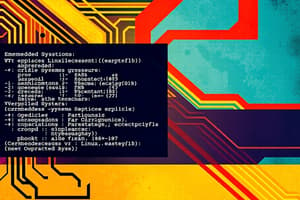Podcast
Questions and Answers
What is the function of a brushed DC motor?
What is the function of a brushed DC motor?
A brushed DC motor is designed to convert DC electricity into mechanical power. It is internally commutated and is designed to be run from a direct current power source.
How can the speed of a brushed DC motor be varied?
How can the speed of a brushed DC motor be varied?
The speed of a brushed DC motor can be varied by changing the applied voltage, which will vary the coil current and thus the strength of the magnetic field.
What is the counter-EMF or back EMF in a brushed DC motor?
What is the counter-EMF or back EMF in a brushed DC motor?
The counter-EMF or back EMF in a brushed DC motor is the voltage produced by the spinning of the motor, which opposes the applied voltage on the motor.
What has replaced brushed motors in many applications?
What has replaced brushed motors in many applications?
Flashcards are hidden until you start studying
Study Notes
EGR326 Lecture 11: DC and Stepper Motors in Embedded Systems
- Objectives of the lecture include understanding the working of a DC electric motor and the advantages of a "brushless" DC motor
- A brushed DC motor is designed to run from a direct current power source and utilizes brushes to facilitate current flow to coil windings
- The armature of a brushed DC motor forms an electromagnet, leading to repulsion and attraction due to the current through its coils
- Varying the applied voltage to a brushed DC motor can change the speed by altering the coil current and the strength of the magnetic field
- The spinning of the motor produces a counter-EMF, opposing the applied voltage on the motor
- Brushed motors are still used for heavy-duty equipment while brushless motors, using power electronic devices, have replaced them in many applications
- Stepper motors work by dividing a full rotation into a number of equal steps, with each step being driven by a separate electrical pulse
- Stepper motors are advantageous due to their ability to accurately position the motor without the need for a feedback system
- Microcontrollers can be used to design an interface to drive a stepper motor, making them suitable for precise control and automation applications
- The lecture aims to provide an understanding of the working principles of both DC and stepper motors, as well as the design and control aspects
- The transition from brushed to brushless motors has been driven by the need for more reliable and maintenance-free motor solutions in various applications
- The lecture provides insights into the practical applications and advantages of both brushed and brushless DC motors, as well as the design considerations for driving stepper motors from microcontrollers
Studying That Suits You
Use AI to generate personalized quizzes and flashcards to suit your learning preferences.




